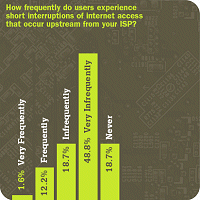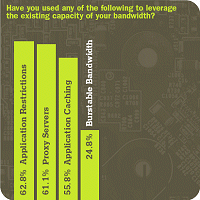Extracurricular :: For technologists who do their homework
Large-district (4,000-plus students) technology coordinators speak out on their experienceswith a fundamental component of the 21st-century school system: internet access.
HIGHLIGHTS
- SCHOOLS RELIANT ON STATE NETWORKS
- T-1, T-3 MOST POPULAR TYPES OF ACCESS
- INFREQUENT INTERRUPTIONS
- BANDWIDTH LEVERAGED BY RESTRICTING APPLICATIONS
internet service provider

internet connection

access interruptions

leveraging bandwidth capacity

(Percentages may add up to 100 due to rounding.)
—Data courtesy of Jeanne Hayes (The Hayes Connection)and Tom Greaves (The Greaves Group).
Read about the full report, "America’s Digital Schools 2006: A Five-Year Forecast," at here.